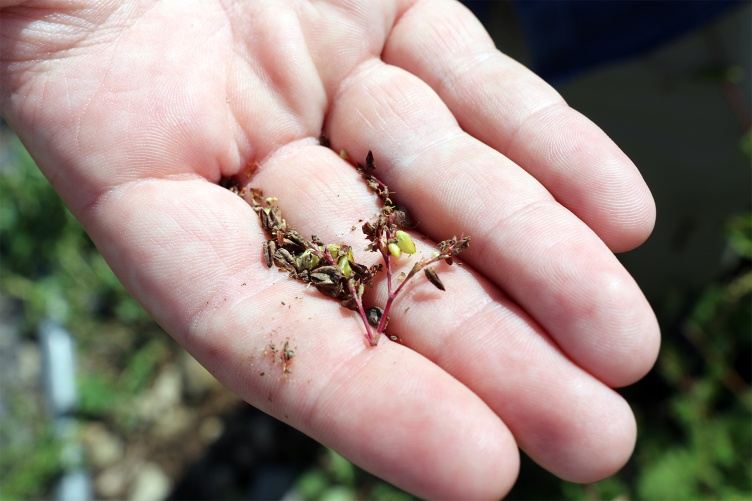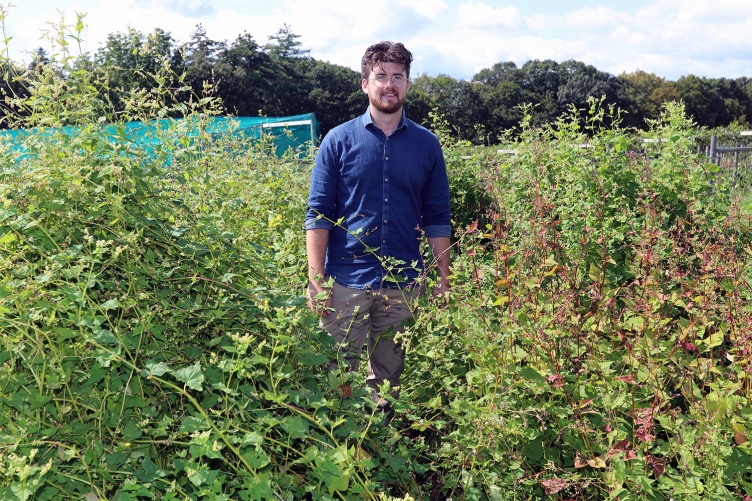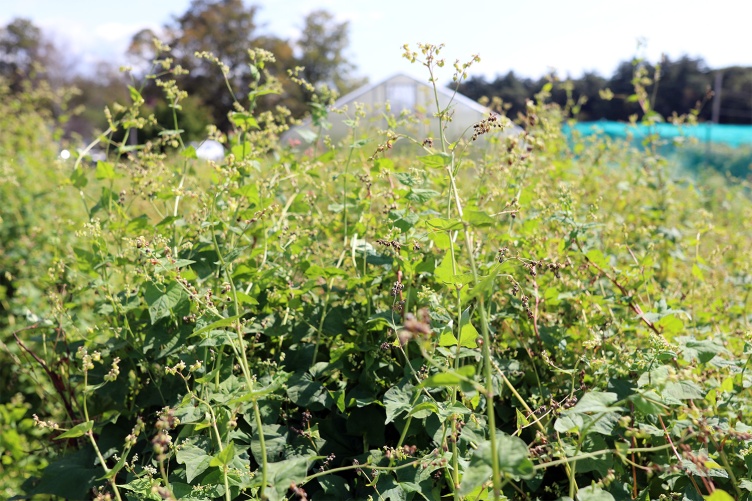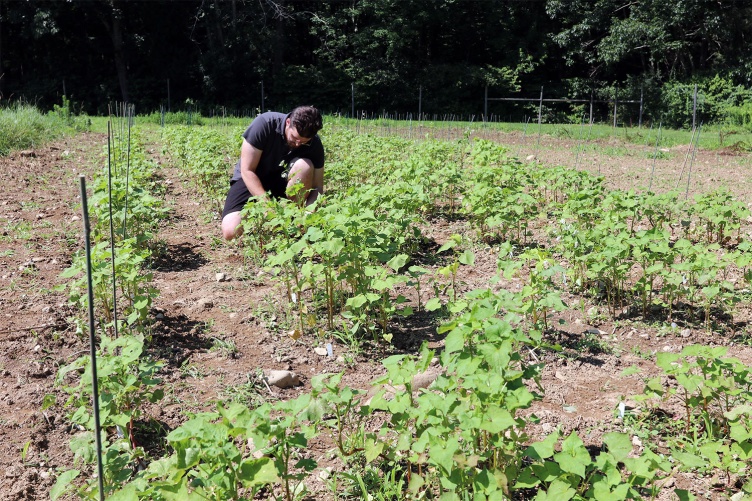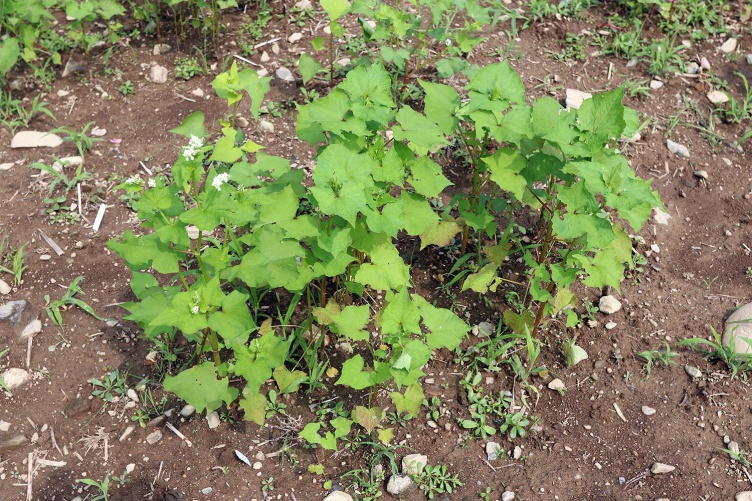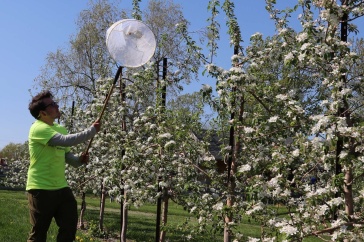Research Goal:
Develop regionally adapted varieties and production guidelines for Tartary buckwheat and support its adoption by Northeast farmers.
Key Terms:
Neglected and underutilized crop species (NUCS): Expand for definition
Plant species of potential use in the food system that are not widely grown due to a historical lack of concerted research investment.
Plant germplasm: Expand for definition
A diverse collection of plant genetic resources, usually in the form of seeds or clonally propagated plants, used for research, breeding, and conservation efforts.
Pseudograin (or pseudocereal): Expand for definition
Any non-grass plant whose seeds are used the way true grains (or cereals) are, including being ground into flour. Pseudograins generally exhibit superior nutritional profiles compared to the true grains. Familiar examples of psuedograins include quinoa, amaranth, and common buckwheat.
Rutin: Expand for definition
A plant pigment found in many fruits and vegetables that has been shown to have several health benefits, including as an antioxidant and anti-inflammatory Among food crops, Tartary buckwheat has some of the highest concentrations of rutin, which is being explored for its possible medicinal effects on neurodegenerative diseases like Alzheimer’s disease.
Self-compatible: Expand for definition
Plants that can set seed using their own pollen. Self-pollination is also referred to as in-breeding and can result in seeds that are true-to-type, giving rise to new plants that are genetically identical to the parental plant. Tartary buckwheat is a self-compatible plant.
Self-incompatible: Expand for definition
Plants incapable of self-pollination and therefore requiring pollen from another individual of the same species for successful fertilization and reproduction. This mating system is referred to as outcrossing or hybridization, and it results in seeds that are not true-to-type. Common buckwheat is an example of a self-incompatible plant.
Tartary Buckwheat Deep Dive
Tartary buckwheat (Fagopyrum tataricum) is native to and was first cultivated in Central Asia. It’s well adapted to cooler climates, thriving at higher altitudes, and has traditionally been grown in high-altitude areas of Nepal, Bhutan, southern China, and India. Renowned for its nutritional value, this gluten-free pseudo-grain is a good source of protein, dietary fiber, vitamins (such as B vitamins), and minerals like magnesium and manganese. It’s especially prized for its antioxidant qualities and is often used in traditional medicine to improve blood circulation and reduce inflammation. Read about the climate resiliency of Tartary buckwheat.
Tartary buckwheat is increasingly recognized as a climate-resilient or climate-ready crop. A hardy plant, it can grow in different soil types, including low-nutrient soils, and has a short season, taking just 70-90 days to mature. It’s relatively drought tolerant, requiring little to no irrigation; can grow in mountainous areas; and has few pests and diseases compared to other cash crops grown on larger scales. In the U.S., Tartary buckwheat is grown on just a handful of farms, mainly in northern states where growing seasons are shorter. It’s largely grown as a specialty crop by farmers interested in its health benefits.
Also known as green buckwheat, bitter buckwheat, Himalayan buckwheat, and many other names, Tartary buckwheat is in the same genus as common buckwheat (Fagopyrum esculentum) and shares some of its growth characteristics and nutritional qualities. However, Tartary buckwheat contains approximately 40 times the amount of rutin than common buckwheat. Additionally, because of the difference in the reproductive systems of the two species (inbreeding vs. outcrossing), developing improved varieties and studying the genetics of key traits for commercial cultivation is relatively easier in Tartary buckwheat.
UNH researchers are using advanced science to address challenges facing Northeast growers as a result of climate change. New research from Iago Hale, New Hampshire Agricultural Experiment Station (NHAES) scientist and associate professor, and Noah Abasciano, master’s student in UNH’s genetics program, is seeking to identify an ideal grain crop for the Northeast — one that can be a staple in diets, offers significant nutritional benefits, provides price premiums for New Hampshire producers, and is highly resilient to the increasingly variable and unpredictable weather in the region. And the research team of Hale and Abasciano believe they have an excellent candidate—an underutilized and lesser-known crop known as Tartary buckwheat (Fagopyrum tataricum), a relative of common buckwheat (Fagopyrum esculentum) but one with unique qualities that make it suitable for production on a wide variety of soil types and quality across a broad range of climactic conditions.
Tartary Buckwheat: A Climate-resilient Crop
Volatile and at times record-breaking weather in late-2022 and in 2023 has been devastating for many New Hampshire farmers. And while Granite State producers will undoubtedly recover and continue sustaining the regional food systems that depend on New Hampshire’s agricultural production, 2023's freezes, rains and floods were certainly a reminder that there can never be too many tools in farmers’ toolboxes for resilient food production. Tartary buckwheat, with its preference for cooler climates and ability to grow quickly (in just a few months) and with limited water, makes the plant ideal for the region and for fluctuating weather patterns.
Currently, Tartary buckwheat is grown commercially on only a handful of U.S. farms and almost entirely in northern states with cool climates and shorter growing seasons. In mountainous sections of Southern China and other Asian countries, Tartary buckwheat is much more common and is prized for its nutritional value, as well as its growing ability in poor quality soil in which most other crops won’t survive.
“The 2022 growing season was hot and extremely dry, taxing the irrigation capacity of many of our region’s farms,” described Hale. “And this year [2023]? It’s been so wet that farmers struggled to get onto their fields in time for planting.”
“A species like Tartary buckwheat is climate-ready in the sense that it tolerates extreme temperatures (heat and cold) and extreme moisture regimes (drought and saturation),” Hale added. “It matures fast, giving producers flexibility in integrating it into their cropping systems. It also establishes quickly, outcompeting weeds, and grows in poor soils without demanding costly inputs.”
In addition to its climate resiliency characteristics, Tartary buckwheat (like common buckwheat) is gluten free and contains more than double the amount of protein found in common grains, as well as high levels of essential amino acids, minerals, and one of the highest levels of the plant pigment known as rutin. Rutin has strong anti-inflammatory and antioxidant properties and has been shown to improve blood vessel health and decrease arthritis. Additionally, it’s been linked to decreases in cancer and neurodegenerative diseases like Alzheimer’s.
“In its native region, beyond its use as a delicious and nutrient-dense grain, Tartary buckwheat has long been recognized as a functional food—meaning a food that benefits one’s health in ways we usually only associate with medicine,” Hale added.
A New Plant Breeding Program at UNH
Hale and Abasciano began their work by requesting seed of the full collection of 78 diverse Tartary buckwheat accessions (genetically distinct plants) maintained by the USDA and then growing them in the UNH Macfarlane Research Greenhouses in the fall of 2022. In the spring of 2023, they sowed small plots of the same germplasm collection at UNH’s Woodman Horticultural Research Farm, allowing them a first look at their performance in the field in addition to evaluating each accession’s response to different sowing dates (late spring, early summer, and mid-summer).
“A species like Tartary buckwheat is climate-ready in the sense that it tolerates extreme temperatures and extreme moisture regimes...It matures fast, giving producers flexibility in integrating it into their cropping systems.” ~ Iago Hale, associate professor, agriculture, nutrition and food systems
Tartary buckwheat’s ability to grow rapidly—in just a few months—allows the researchers to quickly identify accessions with desirable characteristics for breeding into an improved variety. In theory, the ability of the species to self-pollinate (unlike common buckwheat, which cross pollinates) will facilitate the development of structured breeding populations and, ultimately, improved varieties. This study represents the first characterization of the USDA’s Tartary buckwheat germplasm collection and, partly because of the limited research done on the species—especially in the U.S.—Hale and Abasciano must first determine what those desired traits are.
“It’s early in the breeding process, so we’re still trying to figure out the characteristics that would be important to commercial production,” said Abasciano. “However, two things we’re looking at—that our partners at the USDA’s Plant Genetic Resources Unit, which provided the initial seeds, asked us to study—are plant lodging and seed shattering.”
The ideal plant would be short, germinate seeks quickly, produce lots of seeds that stay attached to the plant (i.e., does not shatter easily), and does not fall over (or lodge) easily.
“In this first look at the collection, we've been excited to see lines exhibiting some of those characteristics,” added Abasciano. “But of course, no one line has the complete package. But that’s where breeding comes in—we’ll pick the ones with good height and low lodging and shattering and try to combine them.”
For now, at this small research scale, careful harvesting takes place by hand. However, when grown at a commercial scale, the plants could be harvested with traditional small grain harvesting equipment.
Plant breeding is a lengthy process, especially for a crop like Tartary buckwheat, which has seen limited prior work, explained Hale. Despite the plant's short generation cycle, a project of this scale will still require a decade or more to complete.
“There are questions that we need to ask, questions that this project could address,” said Hale. “Questions like, 'What will we be growing in this region a generation from now, amid unprecedented climate stress?' and 'What options will our growers have, and what preparations must be made to ensure those options are available when needed?'”
Climate-resilient agriculture refers to the agricultural practices and systems that are designed to withstand and adapt to the challenges posed by climate change. Climate change is causing shifts in weather patterns, increased temperatures, altered precipitation patterns, and an increased frequency of extreme weather events, all of which can have significant impacts on agriculture. Climate-resilient agriculture aims to minimize these impacts and ensure the long-term sustainability of food production.
Some key components of climate-resilient agriculture include:
- Crop and Variety Selection: Farmers choose crop varieties that are better suited to the changing climate conditions, such as drought-resistant or heat-tolerant crops. These varieties are often developed through breeding programs.
- Soil Health: Enhancing soil health through practices like conservation tillage, crop rotation, and the use of organic matter can improve the soil's ability to retain water and nutrients, making it more resilient to climate-related stresses.
- Diversification: Diversifying crops and livestock can reduce the risk associated with climate-related challenges. Crop diversity can help ensure that at least some crops thrive under changing conditions.
- Adaptive Pest and Disease Management: Monitoring and early detection of pests and diseases, along with the use of integrated pest management strategies, can reduce crop losses due to changing conditions.
- Infrastructure and Technology: Investing in resilient infrastructure, such as climate-resilient storage facilities and transportation systems, and adopting technology like precision agriculture can improve overall farm resilience.
- Capacity Building: Providing farmers with training and education on climate-smart practices and techniques is essential for successful adoption.
Climate-resilient agriculture not only helps farmers adapt to changing conditions but also contributes to reducing greenhouse gas emissions by increasing resource-use efficiency and reducing deforestation and land degradation. It is an essential component of sustainable agriculture in a world facing the challenges of climate change.
This material is based on work supported by the NH Agricultural Experiment Station through joint funding from the USDA National Institute of Food and Agriculture (under Hatch award number 7005933) and the state of New Hampshire.
-
Written By:
Nicholas Gosling '06 | COLSA/NH Agricultural Experiment Station | nicholas.gosling@unh.edu

















































